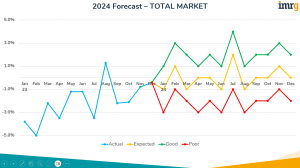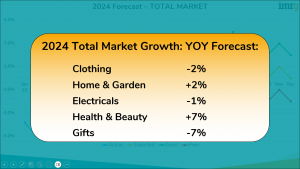By Ellie-Rose Davies, Content Executive, IMRG
After a difficult year for online retail in 2023, with consistent declines reported for many retailers, industry experts are making their predictions for what is to come this year. This blog outlines some great expectations for 2024, enabling retailers to identify focus points for growth and to be best prepared for what is to come.
IMRG’s Forecast for 2024
Each year IMRG release a forecast for the year ahead based on historic data and current insights. This forecast reveals our monthly revenue growth predictions for the total market and individual product categories.

As you can see on the chart, we have revealed what we expect (yellow line) for online retail revenue growth in 2024, as well as a potential good (green line) or bad (red line) outcome. We expect there to be three noticeable moments of year-on-year (YoY) growth throughout the year, where we predict that retailers will be able to build on some of the worse performing months in 2023, such as February and July.
August was particularly positive in 2023, and owing to the tough comparator, we predict a YoY decline for August 2024. While we do expect some declines, most months we predict a growth rate somewhere between +1% YoY and -1% YoY, signalling that we expect little fluctuation in performance from last year.

Out of all the product categories tracked in IMRG’s Online Retail Index, health & beauty was the top performer in 2023 (+10.4% YoY), and we only expect positive things (+7% YoY) for this category in 2024. The other category we expect will experience some growth is home & garden (+2% YoY).
The two categories that struggled the most throughout 2023 was clothing and gifts and, unfortunately, we expect further declines for these retailers in 2024. We expect a lesser decline for electrical retailers in 2024, of whom performed better than expected in 2023 (-0.6% YoY).
Each week you can see how the industry has performed and benchmark your performance using IMRG’s Digital Dashboard.
Four great expectations for 2024:
1. Greater customer-centricity and relevancy
With customer acquisition and retention being a top priority for retailers this year, more retailers will welcome customer-centric selling, which means heightened personalisation and relevant communication.
François Rychlewski, VP of Sales EMEA at SheerID, exclaims that ‘To stand out from fierce competition, retailers should deliver hyper-personalised, curated shopping experiences – from online shops, third party marketplaces, apps, to stores.’
‘In 2024, we expect to see retailers prioritise collecting high-quality, first-party customer data to serve customers in their moment of need in their shopper journey— through product recommendations, personalised rewards, or targeted messaging,’ says François.
He continues, ‘Brands offering a seamless, unified omnichannel experience – putting the customer first – will build more long-term loyalty and win in 2024.’
However, many UK-based retailers tend to overlook the importance of adapting their communication to their international customers, who may share different preferences and lifestyles. Offering relevant experiences is crucial seen as Alex Bryan, Customer Success Manager at Loqate, reveals that, ‘One of the standout trends that will dominate in 2024 is the surge in cross-border commerce.’
Alex says, ‘Thanks to advancements in technology, logistics, and payment systems, small and large enterprises alike can now tap into a global customer base. Consumers too are more open to cross-border shopping as seen by the phenomenal success of brands like Temu and Shein.’
With demand for cross-border selling, Alex urges retailers to ‘ensure they are well equipped to handle not only cross-border logistics but also collecting and managing the complexities of international customer data.’
Thinking about how to actualise personalised experiences is Christina Augustine, COO at Bloomreach. She exclaims, ‘AI has disrupted the retail industry and challenged brands to think about how they communicate with their customers, at scale. This year, we will see retail brands leverage AI to become more customer centric, tailoring their communications at every step of the customer journey.’
‘Retailers are prioritising personalisation now more than ever, and across multiple channels,’ where Christina gives the examples of product recommendations, predicting returns, and conversational commerce. She suggests for retailers to use AI tools that will ‘support your team in creating impactful customer experiences.’
2. Increased customer touchpoints and communication
Seen as customer loyalty is proving more difficult, it has become integral for retailers to increase their customer touchpoints and to go the extra mile with communication.
Retailers are growing their online identity through having engagements on various communication platforms and by speaking to customers at every stage of their purchasing journey, including the important post-purchase stage, to improve customer retention.
Gavin Murphy, CMO at Scurri, says ‘With the cost of acquiring new customers continuing to rise, tight privacy rules limiting marketing effectiveness, and the depreciation of third-party cookies, in 2024 retailers will need to double down on engaging existing customers to maximise loyalty and generate repeat purchases.’
It is worth ‘remembering that customer engagement continues beyond the buy button – the point at which shoppers are arguably the most engaged during the buying journey,’ shares Gavin.
He continues, ‘Scurri research shows 81% of shoppers will always open emails from a retailer or brand if they are updating the customer on the status of their order delivery. Post-sales communication can be used to up-sell and cross-sell by highlighting other products within delivery tracking emails, offering additional and valuable insights that take place off the website.’
In addition, ‘This communication can be used to start the customer’s next buying cycle, enhance customer experience, and dial-up sales and conversion performance.’
Retailers can also use indirect customer touchpoints, such as influencer content, to improve brand awareness and loyalty. Robert Davinson, Global Head of Content Marketing at Awin, notes that there has been a ‘slowdown on social,’ where ‘new user growth has started to plateau,’ and ‘ad spend is also expected to flatten out following a huge spike during the pandemic.’
‘One way for brands to insulate themselves from this slowdown on social is to consider partnering with creators on a more direct basis.’ Robert describes how ‘Influencer marketing spend has shown itself to be more resilient and less prone to sudden fluctuations in cost than paid social. And more enterprise brands are increasingly launching their own large-scale creator affiliate programs recently as they seek to work closer with these influential figures.’
3. Improved sustainability efforts
Industry experts have predicted that sustainability will be at the forefront of 2024, where numerous retailers want to invest in being more sustainable, and are aware that they have much work to do.

Mattias Gredenhag, CTO at nShift says, ‘Sustainability is an issue that has been a key focus for retailers and ecommerce companies for some time but the advent of the new EU Corporate Sustainability Reporting Directive (CSRD), which subjects businesses in the region to mandatory sustainability reporting, means it will take on even greater significance in 2024.’
‘Not least because, according to a recent survey, 88% of companies do not yet feel ready to meet the expectations of CSRD and 57% feel they have little or no knowledge of the new reporting obligations that arise from the regulations.’
‘For many companies, the first reports will not be due until 2025,’ says Mattias But it’s vital that businesses covered by the new requirements get to grips with them as soon as possible to ensure they are tracking the data they need.’
Keeley Burridge, Marketing Executive at Intersoft, shares how ‘The European Environment Agency has projected that logistics alone could contribute up to 40% of global carbon dioxide emissions by 2050, and .consumers are becoming increasingly aware of the impact this is having on the climate crisis.’
With more eco-conscious shoppers, Keeley says that online retailers can ‘include strategies such as zero or low-emission delivery fleets, carbon offsetting schemes, and eco-friendly packaging alternatives – 74% of consumers are willing to pay more for products packaged sustainably.’
Returns expert, Laura Garrett, from ReBound also explores the value of being more sustainable, exclaiming, ‘Our recent survey found that 76% of shoppers favour eco-friendly businesses. As a result, more brands will start charging for returns, in a bid to curb excess waste and encourage more sustainable shopping.’
‘We will also start to see more brands and retailers adopt ‘smart returns,’ which will transform reverse logistics through the application of data,’ says Laura. This approach, using data at every step to streamline operations, reduces emissions by optimising routes and minimising unnecessary movements.
Laura continues, ‘The result is a more resilient, adaptive and sustainable process that saves the retailer time and money and enhances the customer experience.’
With the rise of sustainability, it is no wonder that Paul Dodd, Co-Founder and Chief Innovation Officer at Huboo says, ‘Recommerce is set to have a big year in 2024. Whether it’s the drive to be more sustainable, or simply to save money, more shoppers will buy owned rather than new, and I also expect an uptick in the number of people looking to earn a bit extra through recommerce side hustles.’
He continues, ‘Likewise, the appeal of super-fast delivery will diminish as shoppers prioritise cost savings and opt for slower, more economical shipping.’ With customers being more cost-conscious, Paul reveals that ‘From a category perspective, we’re expecting to see a strong year for Food & Drink as people continue to dine in and socialise more in their homes.’
4. More doubling down on fraud
Online retailers have had to navigate a wave of fraud in 2023, and this year they will be seeking ways to limit the impact.
Director of Financial Services and EMEA Marketing, Amal Ahmed at Signifyd, describes how ‘The era of future-focused ecommerce, marked by instant approvals, also widens the door for potential fraudsters seeking to exploit rapid transactions. For businesses, the sweet spot will lie in harmonising three key elements: customer experience, fraud protection, and reducing friction in payments.’
Amal says, ‘At a time when fraud pressure is up 42% YoY, merchants must be more savvy about the evolving fraud landscape. A holistic, tailored strategy is crucial.’
From the industry’s predictions of rather poor performance in 2024, and with IMRG predicting flat growth (0%) for the entire year, Founder of Chargebacks 911, Monica Eaton, shares that ‘In an environment of low growth and lower customer demand, chargeback fraud—also known as ‘friendly fraud’— is sure to go up.’
She says, ‘Consumers still need to make purchases but, with their money stretched, some will inevitably turn to making false chargeback claims to get something for nothing. The cost of contesting these chargebacks manually can be extremely significant and can require multiple skilled professionals to be employed by larger companies.’
‘One upside is that inflation, which has been a major problem for the past year, is predicted to go down. This will hopefully make the cost of doing business easier for many companies and allow any that need to borrow money to do so with lower interest rates,’ says Monica.
What do you expect from 2024?
Make the most of IMRG’s insight and keep up to date with weekly trends using:
- The Digital Dashboard
- IMRG’s in-person and virtual events
- Blogs and reports
Published 30/01/2024


